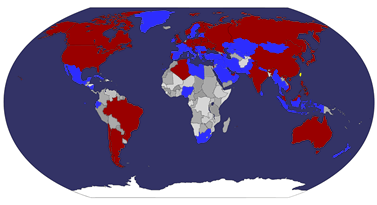FAUNE CROATE - POISSON D'EAU DOUCE


3.50HRK: Adriatic Sturgeon - Latin Acipenser naccarii Bonaparte, 1836. Foreign names: Adriatic Sturgeon (English); Adriastör (German); Storione del Naccari (Italian) The Adriatic Sturgeon is an endemic species of the Adriatic Sea and the sub-Adriatic rivers. Its habitats are the rivers of northern Italy and in Croatia it is found in the river mouths of the rivers flowing into the Adriatic Sea. It is more common in the northern Adriatic and ranges along the eastern Adriatic coast all the way to Albania. It is a rare species. The Adriatic Sturgeon may grow up to 2000 mm in length and reach the weight of 25 kg, although it is usually considerably smaller. Its body is elongated and spindle-shaped and is not covered with scales but with bony plates or scutes, extending along the body in five rows. Hence the name of the subclass, Chondrostei, chondrosteans. Their back is olive-green and brown, the sides are lighter in colour and their belly is white. The top of the head is a projecting wedge-shaped snout, broad and relatively short, and with the rounded tip. The Adriatic Sturgeon has a small inferior, i.e. subterminal moth (mouth posterior to the tip of the snout). The lips are meaty and the lower one is interrupted in the middle. Adult sturgeons are toothless and in the young ones they are stunted. Their eyes are small and poorly developed, so that their barbels are important tactile organs for the detection of food on the river bottom. The barbels are found on the lower side of the snout, closer to its tip rather than to the mouth. The first rays of pectoral fins are strong and bony. The dorsal fin is located far on the back and the caudal fin is asymmetric (heterocercal). The Adriatic Sturgeon feeds on invertebrates from the bottom and small fishes. The Adriatic Sturgeon is an anadromous species: it lives in the sea and migrates to fresh water (rivers) to breed. It is a long-living species that grows slowly. In the beginning it grows rather fast and at the end of its second year it reaches about 0.5 m in length and weighs approximately 1 kg. However, to reach 1 m in length and the mass of 8 to 9 kg, it takes another 10 years. The males are capable of reproduction between the age of six and eight years, and the females between the age of eight and twelve years. It spawns in the spring, from March to May. The female spawns once in two to four years and the male once a year or every second year. After hatching the young fishes migrate to the sea, where they grow up. There is few information about the biology of this species. The flesh of the Adriatic Sturgeon is used for food but their roe is not processed into caviar. The Adriatic Sturgeon is a demersal species inhabiting freshwater, brackish water and seawaters of the Adriatic. It lives in the sea, at places with silty or sandy bottom. It mostly stays close to the river mouths, up to a depth of 40 m, although it sometimes goes deeper. The Adriatic Sturgeon is threatened by the pollution of watercourses and partition of rivers, which prevents their migrations. Another great problem is overfishing of still growing fishes. It occurs very rarely in the nature and the populations are slowly growing. According to the IUCN Red List, this species is Critically Endangered (CR) in Croatia. Pursuant to the existing protection based on the law, the Adriatic Sturgeon is a strictly protected species. The international protection documents mentioning this species are the Bern Convention (Convention on the conservation of European wildlife and natural habitats) (Appendix II), the Washington Convention (The Washington Convention on International Trade of Endangered Species of Wild Fauna and Flora – CITES) (CITES II) and the European Habitats Directive (the Council Directive on the conservation of natural habitats and of wild fauna and flora (Appendix II and V).
5.00HRK: Visovac Goby - Latin Knipowitschia mrakovcici Miller, 1990. (nomen nudum) Foreign names: Visovac Goby (English); Visovac Grundel (German) The Visovac Goby occurs only in Croatia, in Visovac Lake on the Krka river. This fish was named after a Croatian ichthyologist, Professor Milorad Mrakovčić, Ph.D., who discovered and recognised it as a new species in 1989. The Visovac Goby has the elongated body and laterally flattened to the tail. There are few scales, only on the sides and the tail. Males are slightly bigger and heavier than females on average and have more than 10 transversal stripes on the sides. Dimorphism is very visible during the spawning season, when the males have darker heads and fins. The Visovac Goby can reach 45 mm in length. The information about the biology of this species is very sparse. The spawning season ranges from early spring to September, and the reproductively mature population spawns several times during that period. The male makes a nest in which it stays during spawning and after spawning it protects it aggressively, defending the ova until hatching of the fry. The Visovac Goby feeds on nutrients found on the bottom, mostly small water invertebrates. Its life span is short. The Visovac Goby is a demersal, freshwater fish inhabiting the silty, sandy and gravel bottom of Visovac Lake on the Krka river. It has a small movement range. Due to its exceptionally limited habitat, the Visovac Goby belongs to the category of endangered species, sensitive to eutrofication, i.e. the quantity of nutrients in the water, pollution and all other changes in its habitat. According to the IUCN Red List, this species is Endangered (EN) in Croatia. Pursuant to the existing protection based on the law, the Visovac Goby is a strictly protected species.
5.00HRK: Danubian Bream - Latin: Ballerus sapa (Pallas, 1814) Foreign names: Danubian Bream, White-eye Bream (English); Zobel (German) The body of the Danubian Bream is laterally flattened and relatively high. The most conspicuous on its small head is the size of the eyes. The eyes are equal in diameter or bigger than the distance from the rostrum to the beginning of the eye. This does not apply to young fishes, in which the eyes are not a determination feature. The mouth is small and semi-inferior. The back is dark blue to greenish and the sides and the belly is silver. The anal fin is extremely long and extends to the tail and its base is three times longer than the base of the dorsal fin. The length of the anal fin covers one third of the body length. The outer edge may be darker. During the spawning season, males have skin warts on the body and fins. The scales are of medium size and there can be 47 to 54 of them in the lateral strip. The Danubian Bream usually reaches the length of 15 to 25 cm, or maximum 40 cm, and the mass of approximately 1 kg. Young fishes feed on zooplankton, whereas the adults feed on larvae of insects, molluscs and small crabs, and sometimes also on aquatic plants. It reaches breeding maturity in its third or fourth year. It spawns in April and May. Females lay up to 150 000 eggs on aquatic plants. They live in schools and are more active during the night. The Danubian Bream inhabits big lowland rivers, estuaries and backwaters. Its favourite spawning locations are more peaceful places in rivers with thick aquatic plants. Its habitats in Europe are the Danube basin and the rivers flowing into the Black Sea, the Caspian Sea and the Aral Sea, especially on the territories of the former Soviet Union. Its habitats in Croatia include the rivers flowing into the Danube: the Sava, the Drava and the Danube itself, as well as its bigger tributaries. The Danubian Bream is endangered by partitions, regulation and channelling of water streams, as well as by their pollution. According to the IUCN Red List, this species is Data Deficient (DD) in Croatia. Pursuant to the existing protection based on the law, the Danubian Bream is a strictly protected species. The international protection document mentioning this species is the Bern Convention (Appendix III).









.jpg)























 taiwan
taiwan  cover or postcard
cover or postcard  FDC
FDC 






























































































No comments:
Post a Comment